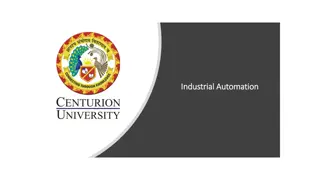System Level Design and Automation Overview
Embedded systems are evolving towards complex System-on-Chip (SoC) designs, integrating various components into a single chip. This course covers SoC characteristics, applications, design flows, and challenges. Topics include VLSI design, designing for concurrency, heterogeneity, and the motivation behind SoC integration. Students engage in projects, assignments, and presentations to deepen their understanding. The course emphasizes system-level design automation for optimizing design metrics in SoCs. Discussion on embedded system characteristics: computational tasks, reactivity, heterogeneity, networked systems, flexibility, and reconfigurability.
Download Presentation

Please find below an Image/Link to download the presentation.
The content on the website is provided AS IS for your information and personal use only. It may not be sold, licensed, or shared on other websites without obtaining consent from the author.If you encounter any issues during the download, it is possible that the publisher has removed the file from their server.
You are allowed to download the files provided on this website for personal or commercial use, subject to the condition that they are used lawfully. All files are the property of their respective owners.
The content on the website is provided AS IS for your information and personal use only. It may not be sold, licensed, or shared on other websites without obtaining consent from the author.
E N D
Presentation Transcript
ECE-777 System Level Design and Automation Introduction Cristinel Ababei Electrical and Computer Department, North Dakota State University Spring 2012 1
Outline Syllabus, focus of this course, topics covered, project Complex embedded systems are becoming SoCs SoCs: characteristics, applications, complexity, concurrency, heterogeneity VLSI design flow vs. SoC design flow Summary 2
Syllabus 3
Syllabus Topics covered No single textbook yet, research papers Project HW assignments and in-class presentations Grading Class website www.dejazzer.com/ece777/index.html BlackBoard for additional materials 4
SoC era has come Motivation is increase of performance , decrease of costs and time-to-market 5
Increasing integration: Complex embedded systems SoCs 6
System-on-Chip (SoC) SoC refers to integrating all components of an electronic system into a single chip (what motivates such integration?): Microprocessors, microcontrollers, DSP s ASIC s, FPGA s Memories, IO s, A/D and D/C converters Analog, mixed-signal, RF blocks, voltage regulators Communication infrastructure: Bus based, Network- on-Chip (NoC). System-level design (automation) and simultaneous optimization of numerous design metrics is key challenge. A SoC is a complex embedded system. 7
Embedded systems characteristics Computational Interact (sense, manipulate, communicate) with the external world: sensors, actuators Reactive: at the speed of the environment Heterogeneity: hardware/software blocks, mixed architectures Networked: shared, adaptive, sensor networks (buildings, environmental monitoring), smart products, wearable computing Flexibility: can run/implement multiple applications sequentially or concurrently - concurrency Reprogrammability/reconfigurability: flexibility in upgrading, bug fixing, product differentiation, product customization Part of a larger system (system within system) Performance and constraints: Timing (frequency, latency, throughput) Cost, power, area, weight, temperature, reliability 8
Key recent trends Increasing computation demands, increasing complexity e.g. multimedia processing in set-top boxes, HDTV Increasingly networked Increasing need for flexibility time-to-market under ever changing standards HW-SW co-design Higher integration: more blocks on the same chip IP reuse, platform based design, NoC vs. Bus Systems are designed and built as systems of systems . Diversity in design methodologies, platform dependent, lack of standards quality risks, customer confusion 9
Complexity and heterogeneity Complexity - handled by working at higher levels of abstraction, hierarchy Heterogeneity - handled by sophisticated HW-SW co-design methodologies controller processes control panel Real-time OS UI ASIC controller processes DSP DSP Programmable DSP Programmable DSP Assembly Code Assembly Code Dual-ported RAM CODEC 11
Application domains Consumer electronics (HDTV, digital cameras, camcorders, game consoles), communications (cell phones), space, automotive (video, audio, control), military (radar, sonar), health. More than 30% of the cost of a car is now in Electronics. 90% of all innovations will be based on electronic systems. Modern cars: up to ~100 processors running complex software. Estimated 98% of 8 Billion CPUs produced in 2000 used for embedded apps. 12
More applications Read ( IP reuse key concept in system level design applies to course design too): The Introduction presentation of ECE-249 at Berkeley: http://chess.eecs.berkeley.edu/design/2010/lectures/Intro ductionEE249_10.pdf The introduction presentation of CSE-237D at UCSD: http://haduken.ucsd.edu/cse237d/topic01.ppt 13
Example: ARM 18
Handling heterogeneity: HW/SW co-design Fixed Processor Architecture Application Specific HW Block Application-Specific Instruction Set Processor 19
SoC design flow Various design methodologies Computation centric: Bus based past and present Communication centric: Network-on-Chip based more recent Key design steps: Intertwined subtasks Modeling/specification Refining (or functional/structural partitioning ) : the function to be implemented into smaller, interacting pieces hierarchy HW/SW partitioning: elements in the refined model to either (1) HW units, or (2) SW running on custom hardware or a suitable programmable processor Allocation (platform design): select components/blocks/IPs Binding (mapping = implementation): assign functions to HW/SW components Scheduling: compute the times at which the functions are executed. This is important when several modules in the partition share a single hardware unit. Verification & debugging Crucial is the co-design and joint optimization of hardware and software For NoC based approach: network synthesis step is crucial 20
System level design System-level design is a complex synthesis tasks software synthesis and code generation hardware synthesis interface and communication synthesis hardware/software partitioning and component selection hardware/software scheduling Major Components: Application specification Design space exploration and system optimization Estimation: Synthesis based on abstraction only makes sense if there are powerful estimation methods available: Estimate properties of the next layer(s) of abstraction. Design decisions are based on these estimated properties. 23
Hardware vs. Software Modules A significant part of the problem is deciding which parts should be in software on programmable processors, and which in specialized hardware. Hardware = functionality implemented via a custom architecture (datapath + FSM) Software = functionality implemented in software on a programmable processor Key differences: Multiplexing software modules multiplexed with others on a processor hardware modules are typically mapped individually on dedicated hardware Concurrency processors usually have one thread of control dedicated hardware often has concurrent datapaths 24
Challenges Increasing application complexity large systems with legacy functions mixture of event driven and data flow tasks examples: multimedia, automotive, mobile communication Increasing target system complexity: heterogeneity HW/SW co-design mixture of different technologies, processor types, and design styles large SoCs combining components from different sources, distributed system implementations Design chain integration: Design steps role Methodology Tools Parallel architectures Embedded software and control Numerous constraints and design objectives examples: cost, power consumption, timing constraints, dependability/reliability 25
Design methodologies Past and present: Ad hoc approaches based on earlier experience with similar products, and on manual design. HW-SW partitioning decided at the beginning, and then designs proceed separately. Present and future: HW-SW co-design Design automation (CAD) tools: very challenging 26
Tools, companies, academia (open-source) Design tools provided directly by SoC vendors or EDA companies CAD tools for hardware Software development environments for software Implement a variety of design methodologies SoC companies http://en.wikipedia.org/wiki/List_of_system-on-a-chip_suppliers Academia examples http://ptolemy.eecs.berkeley.edu http://www.cecs.uci.edu/~gajski/tools.html http://vlsiarch.ecen.okstate.edu/?page_id=12 Other resources http://embedded.com http://www.design-reuse.com http://www.soccentral.com http://www.socconference.com NoC Blog http://networkonchip.wordpress.com 27
Observations We are in the middle of a revolution in the way electronics products are designed System design is the key (also for IC design!) Start with the highest possible level of abstraction (e.g., control algorithms) Establish properties at the right level Use formal models Leverage multiple scientific disciplines 28
Summary Course syllabus, topics outline SoC era has come: characteristics & applications Design flows System design is the key Emphasis in this course will be put on design automation and on NoC design paradigm Project (with milestones) is 50% of final grade HW #1: 15-slides style presentation 29























